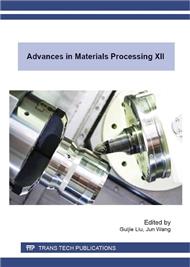[1]
National Natural Science Fund Committee of China, Development Strategy of Chinese Subjects in Next Ten Years, materials science, Science Press, Beijing, (2012).
Google Scholar
[2]
Y. Estrin, A. Vinogradov, Extreme grain refinement by severe plastic deformation: a wealth of challenging science, Acta. Mater. 61 (2013) 782-817.
DOI: 10.1016/j.actamat.2012.10.038
Google Scholar
[3]
D.F. Zhang, H.J. Zhang, W. Lan, et al, Some research progress of high-strength magnesium alloys, Cailiao Rechuli Xuebao 33 (2012) 1-8.
Google Scholar
[4]
M. R. Rokni, A.Z. Hanzaki, H.R. Abedi, Microstructure evolution and mechanical properties of back extruded 7075 aluminum alloy at elevated temperatures, Mater. Sci. Eng. A. 532 (2012) 593-600.
DOI: 10.1016/j.msea.2011.11.020
Google Scholar
[5]
S.M. Fatemi-Varzaneh, A. Zarei-Hanzaki, M. Naderi, et al, Deformation homogeneity in accumulative back extrusion processing of AZ31 Magnesium alloy, J. Alloy. Compd. 507 (2010) 207-214.
DOI: 10.1016/j.jallcom.2010.07.157
Google Scholar
[6]
R.B. Mei, Y.X. Du, L. Bao, et al, Study on hot deformation behavior of 7085 aluminum alloy during backward extrusion process, Modell. Simul. Eng. 2015 (2015) 1-8.
DOI: 10.1155/2015/514863
Google Scholar
[7]
X.Y. Guo, P.C. Wang, S.H. Zhang, et al, Research on unstable flow state of metal in hot backward extrusion, Duanya Jishu. 37 (2012) 62-66.
Google Scholar
[8]
R. Matsumoto, T. Kubo, K. Osakada, Improvement of forgeability of a commercial AZ31B magnesium alloy in cold backward extrusion with counter pressure, Mater. Trans. 49 (2008) 1000-1005.
DOI: 10.2320/matertrans.mc200710
Google Scholar
[9]
K. Osakada, R. Matsumoto, M. Otsu, et al, Precision extrusion methods with double axis servo-press using counter pressure, CIRP Ann. Manuf. Technol. 54 (2005) 245-248.
DOI: 10.1016/s0007-8506(07)60094-8
Google Scholar
[10]
S. Kobayashi, S.I. Oh, T. Altan, Metal forming and the finite element method, Modell. Simul. Eng. 8 (1990) 65-65.
Google Scholar
[11]
J. Liu, Z. Cui, C. Li, et al, Modelling of flow stress characterizing dynamic recrystallization for magnesium alloy AZ31B, Comput. Mater. Sci. 41 (2008) 375-382.
DOI: 10.1016/j.commatsci.2007.04.024
Google Scholar
[12]
Z.H. Chen, Wrought Magnesium Alloy, Chemical Industry Press, Beijing, (2005).
Google Scholar
[13]
S.L. Semiatin, D.P. Delo, E.B. Shell, Effect of material properties and tooling design on deformation and fracture during equal channel angular extrusion, Acta. Mater. 48 (2000) 1841-1851.
DOI: 10.1016/s1359-6454(00)00019-7
Google Scholar


